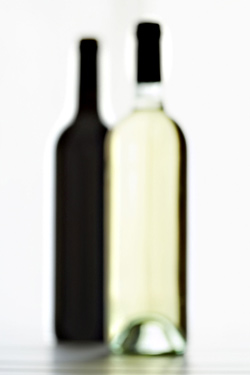While expounding ad nauseam on the two main styles of port, ruby and tawny, most wine books dedicate a measly one or two token sentences to the white sibling. Aficionados dismiss white port as banal, and Englishmen refuse to take it seriously. This should be the first big clue that it’s worth trying. White port may not be anything to wax philosophical about, but as a cocktail, it’s refreshingly first-class.
White port is a dry-to-semisweet aperitif made from white port grapes. Some four-dozen grapes are approved for use in port. White grapes account for almost half of these, but none holds a place among the best varieties for port, all of which are red. This may explain the category’s lowly rep. When making port, winemakers add pure grape spirits during fermentation to stop the reaction, leaving some sugar in the wine. The amount of remaining sugar, along with the ripeness of the grapes, will determine the white port’s style.
On the wine-flavor continuum, white port is richer and fruitier than a fino sherry or white vermouth. Like a nectarine to a peach, it’s not as thick and nowhere near as sweet as a blond dessert wine. Most white port comes off like a butch version of Lillet, the French aperitif. It has a slightly higher alcohol percentage than table wine, around 17 percent. The easiest and tastiest application of white port is to mix it with tonic over ice. Half as potent as a gin and tonic, this is something you can drink all night long.
To me, white port always has a nutty character, with lots of stone fruit flavor. Mix white port with an orange-based liqueur like Cointreau to make a unique aperitif or ultralight version of a martini. A kir—normally white wine with cassis liqueur or syrup—is sassed up with the use of white port. More decadent and aromatic, with a little added sweetness, it’ll make you forget you ever drank cosmos. Dow’s Port, Churchill’s Porto, and Porto Rocha all make interesting white ports that cost between $12 and $20 for a 750-milliliter bottle. Look for the word “lágrima” for an extra-rich version of white port.
A few weeks ago, I attended a public port tasting at the Capitol Club thrown by Robert Bower, 31-year-old heir to the Taylor Fladgate Port operation. A casual affair, the party featured food off the new menu, a mood-appropriate DJ, and a wide array of ports in an effort to attract a new following. It was one of the few times I’ve seen the wine industry get it right. The white port cocktail of the evening, the Siroco Twister, was a huge hit—Fonseca’s Siroco white port, shaken with whole mint and topped with a little soda, served on the rocks or in a cocktail glass. A good time was had by all, and not a stodgy Englishman in sight. Perhaps the wine industry should make an effort to take more things, like white port, less seriously.





